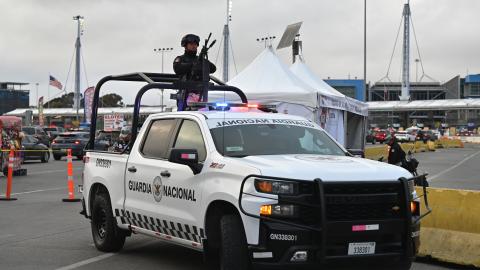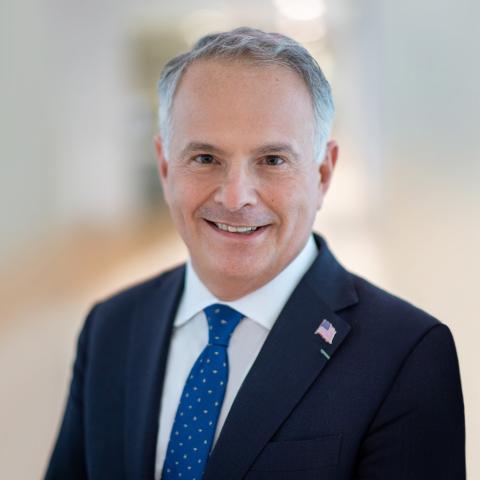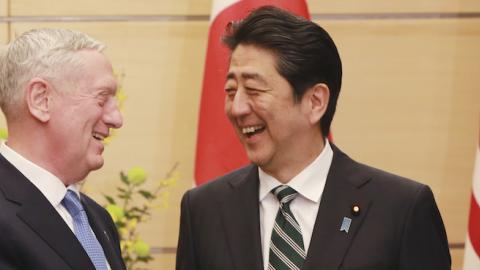Friday’s meeting between President Donald Trump and Japanese prime minister Shinzo Abe will not be their first. The two men sat down together for a successful and substantive chat in Trump Tower on November 17, 2016 — nine days after Mr. Trump’s globe-shaking win. Their next meeting will have two parts: a substantive visit to the White House on Friday before Mr. Trump fêtes Mr. Abe with a golf outing at his “Florida White House” at the Mar-a-Lago resort. In pursuing bilateral ties on greens, Trump and Abe are reprising the golf diplomacy that President Dwight Eisenhower conducted with Abe’s grandfather, Prime Minister Nobosuke Kishi, in the 1950s, but with an important difference. Then, the goal was to heal wounds and build ties between two recent adversaries. Today, the U.S. and Japan are already vital allies. The issue at stake is taking the U.S.–Japan alliance to the next level, so that it can emerge as the true “special relationship” of the Trump presidency.
Historically, the term “special relationship” has been reserved for the U.S. and Great Britain. But while Brexit voters may have much in common with Red State America, on a leadership level, it is Trump and Abe who have much in common. Like President Trump, Prime Minister Abe campaigned on being an agent of change, unafraid to challenge conventional wisdom and focused on sweeping economic and political reforms to revitalize Japan. Also like Mr. Trump, Mr. Abe rejects the notion that the conventional rules of politics and foreign policy are sacrosanct. Instead, he has challenged decades-long policies and become the boldest Japanese leader since the end of World War II.
Mr. Abe’s reforms are now poised to have an enormous impact on U.S.–Japanese cooperation, particularly regarding defense and trade. In the face of fierce opposition, Mr. Abe has lifted major post-war restrictions on Japan’s self-defense forces. Japan can now actively participate in its own self-defense and provide support to U.S. forces in Asia. Mr. Abe has also established or enhanced bilateral defense ties with India, Australia, Vietnam, and the Philippines to counter China’s military build-up and is providing new support to Japan’s defense-technology sector.
These national-security reforms come at a crucial time. As Mr. Trump and Mr. Abe prepare to meet, the U.S. and Japan face an Asia in turmoil and perhaps the most dangerous global security environment since the end of the Cold War. Asian security challenges alone include a rogue North Korea with a growing nuclear capacity to threaten both Japan and the U.S., and Chinese territorial assertiveness in the East and South China Seas, along with expanded military installations and a navy increasingly capable of projecting power, as well as growing Chinese military capabilities in cyber, space, and electromagnetic-pulse warfare. In addition, the current Philippine government is openly hostile to U.S. alliances in Asia, while Russia has installed anti-ship missiles in the Kurile Islands, whose sovereignty has been continuously disputed between Russia and Japan since the end of World War II.
On trade policy, Abe and Trump can also find key areas of mutual benefit, even though Japanese officials were disappointed by the president’s decision to abandon the Trans-Pacific Partnership. Both Japan and the U.S. face economic threats from low-wage labor in China and other emerging manufacturing hubs across Southeast Asia. Both nations need a win-win bilateral trade deal that will promote strong economic growth at home. A bilateral trade deal with the U.S. can serve much of the same economic purpose for Abe that TPP did: serving as an external driver of badly needed economic reform for some of Japan’s most sclerotic and protected sectors, especially agriculture.
Abe seeks greater access to U.S. natural-gas and oil exports to reduce Japan’s dependence on Middle Eastern oil. For Trump, creating increased Japanese demand for U.S. goods would help quiet critics of Japan’s approximately $68 billion trade surplus with the U.S.
Expanding Japanese investment in the U.S., as auto manufacturers Honda, Nissan, and Toyota have shown, would help grow American jobs and the American economy. Japanese press reports indicate that the prime minister will offer a major investment package in U.S. infrastructure, including high-speed-rail systems, as well as major investments in artificial intelligence, robotics, and nuclear energy — all designed to create 700,000 new jobs in the U.S.
Another area of fruitful bilateral cooperation is defense trade. A cooperation pact similar to those the U.S. has with the U.K. and Australia can encourage Japan to become America’s lead technology partner in developing the advanced weapons systems, from high-energy lasers to robotics and drones. These advances can also be important counters to China and North Korea.
Thus the February 10 meeting could not have come at a more important moment. What Franklin Roosevelt and Winston Churchill managed to achieve in forging the 20th century’s “special relationship” between the U.S. and the U.K. could well be replicated for the 21st century between the U.S. and Japan by Trump and Abe. Here’s hoping that at the White House and at the Mar-a-Lago golf course, everyone wins.



















